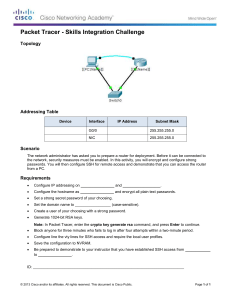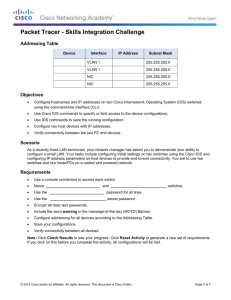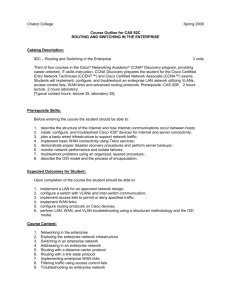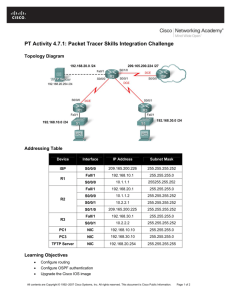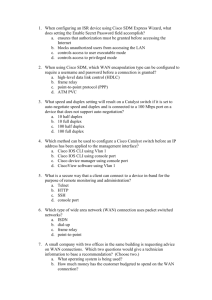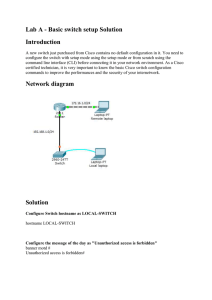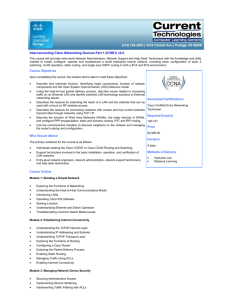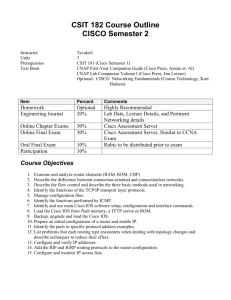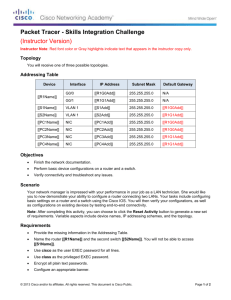ICT/NB Beheerder – Cisco Discovery Semester 2
advertisement
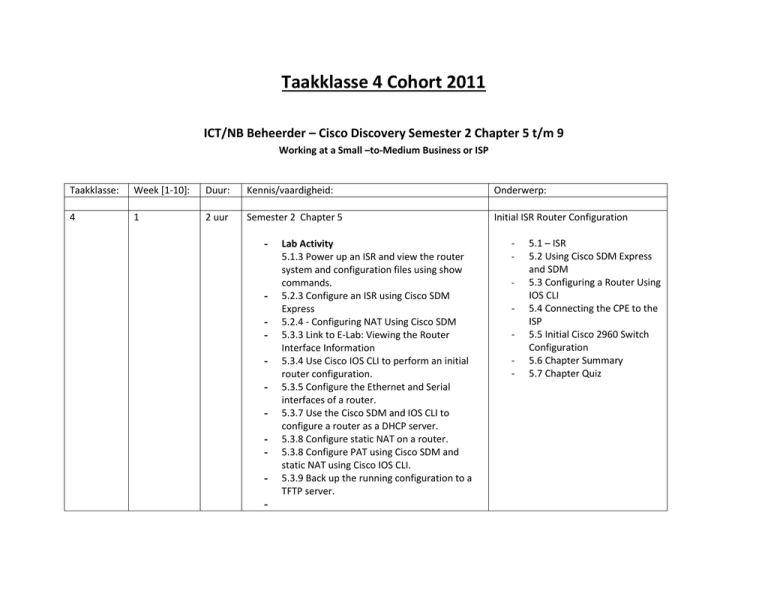
Taakklasse 4 Cohort 2011 ICT/NB Beheerder – Cisco Discovery Semester 2 Chapter 5 t/m 9 Working at a Small –to-Medium Business or ISP Taakklasse: Week [1-10]: Duur: Kennis/vaardigheid: Onderwerp: 4 1 2 uur Semester 2 Chapter 5 Initial ISR Router Configuration - - Lab Activity 5.1.3 Power up an ISR and view the router system and configuration files using show commands. 5.2.3 Configure an ISR using Cisco SDM Express 5.2.4 - Configuring NAT Using Cisco SDM 5.3.3 Link to E-Lab: Viewing the Router Interface Information 5.3.4 Use Cisco IOS CLI to perform an initial router configuration. 5.3.5 Configure the Ethernet and Serial interfaces of a router. 5.3.7 Use the Cisco SDM and IOS CLI to configure a router as a DHCP server. 5.3.8 Configure static NAT on a router. 5.3.8 Configure PAT using Cisco SDM and static NAT using Cisco IOS CLI. 5.3.9 Back up the running configuration to a TFTP server. - - 5.1 – ISR 5.2 Using Cisco SDM Express and SDM 5.3 Configuring a Router Using IOS CLI 5.4 Connecting the CPE to the ISP 5.5 Initial Cisco 2960 Switch Configuration 5.6 Chapter Summary 5.7 Chapter Quiz - 4 2 2 uur 5.3.9 Use HyperTerminal to save and load the running configuration. 5.3.9 Use TFTP to save and load the running configuration. 5.4.3 Complete a WAN upgrade plan based on the business scenario presented. 5.4.3 Configure a serial WAN connection from a Cisco ISR to a CSU/DSU at an ISP. 5.5.2 Power up a Cisco 2960 switch. 5.5.3 Perform a basic switch configuration. 5.5.4 Configure and connect the switch to the LAN using a configuration checklist. 5.5.4 Configure and connect the Cisco 2960 switch. Semester 2 Chapter 5 - - Lab Activity 5.1.3 Power up an ISR and view the router system and configuration files using show commands. 5.2.3 Configure an ISR using Cisco SDM Express 5.2.4 - Configuring NAT Using Cisco SDM 5.3.3 Link to E-Lab: Viewing the Router Interface Information 5.3.4 Use Cisco IOS CLI to perform an initial router configuration. 5.3.5 Configure the Ethernet and Serial interfaces of a router. 5.3.7 Use the Cisco SDM and IOS CLI to configure a router as a DHCP server. 5.3.8 Configure static NAT on a router. 5.3.8 Configure PAT using Cisco SDM and Initial ISR Router Configuration - - 5.1 – ISR 5.2 Using Cisco SDM Express and SDM 5.3 Configuring a Router Using IOS CLI 5.4 Connecting the CPE to the ISP 5.5 Initial Cisco 2960 Switch Configuration 5.6 Chapter Summary 5.7 Chapter Quiz - 4 3 2 uur static NAT using Cisco IOS CLI. 5.3.9 Back up the running configuration to a TFTP server. 5.3.9 Use HyperTerminal to save and load the running configuration. 5.3.9 Use TFTP to save and load the running configuration. 5.4.3 Complete a WAN upgrade plan based on the business scenario presented. 5.4.3 Configure a serial WAN connection from a Cisco ISR to a CSU/DSU at an ISP. 5.5.2 Power up a Cisco 2960 switch. 5.5.3 Perform a basic switch configuration. 5.5.4 Configure and connect the switch to the LAN using a configuration checklist. 5.5.4 Configure and connect the Cisco 2960 switch. Semester 2 Chapter 6 - Routing Packet Tracer Activity - 6.1 Enabling Routing Protocols 6.2 Exterior Routing Protocols 6.3 Chapter Summary 6.4 Chapter Quiz - 6.1.1 Manually configure and reconfigure static routes. - 6.1.2 Link to Hands-on Lab: Creating a Network Diagram from Routing Tables 6.1.5 Configure and verify RIP. 6.2.4 Configure BGP on the external gateway router. 4 4 2 uur Semester 2 Chapter 6 - Routing Packet Tracer Activity - 6.1 Enabling Routing Protocols 6.2 Exterior Routing Protocols 6.3 Chapter Summary 6.4 Chapter Quiz - 6.1.1 Manually configure and reconfigure static routes. 6.1.2 Link to Hands-on Lab: Creating a Network Diagram from Routing Tables 6.1.5 Configure and verify RIP. 6.2.4 Configure BGP on the external gateway router. Semester 2 Chapter 7 - 4 5 2 uur Lab Activity - - 4 6 2 uur 7.3.1 Set up name resolution using the HOSTS file. 7.3.3 Examine the interface of a Windows DNS server to view the cached information from a DNS lookup. 7.3.3 Using a Windows server, create primary and secondary DNS zones. Semester 2 Chapter 8 Lab Activity - 8.1.3 Perform the data security tasks needed to analyze and secure local and transmitted data. ISP Services - 7.1 Introducing ISP Services 7.2 Protocols That Support ISP Services 7.3 Domain Name System 7.4 Services and Protocols 7.5 Chapter Summary 7.6 Chapter Quiz ISP Resposibility 8.1 ISP Security Considerations 8.2 Security Tools 8.3 Monitoring and Managing the ISP 8.4 Backups and Disaster Recovery 8.5 Chapter Summary 8.6 Chapter Quiz - - 4 7 2 uur 8.2.1 Determine where to implement ACLs and port filters to help protect the network. 8.2.2 8.2.4 In this activity, you will configure WEP security on both a Linksys wireless router and a workstation. 8.2.5 Recommend an anti-X software package for a small business. 8.3.1 Examine an SLA and practice interpreting the sections of the SLA. 8.3.2 Download, install, and then conduct a network capture with Wireshark. 8.3.3 Use Telnet to manage remote network devices. 8.3.4 Configure a remote router using SSH. 8.4.2 Plan a backup solution for a small business. 8.4.2 Use a TFTP to backup and restore a Cisco IOS image. 8.4.3 Use ROMmon and tftpdnld to manage an IOS image. Semester 2 Chapter 8 Lab Activity - 8.1.3 Perform the data security tasks needed to analyze and secure local and transmitted data. ISP Resposibility - - 8.2.1 Determine where to implement ACLs and port filters to help protect the network. - 8.1 ISP Security Considerations 8.2 Security Tools 8.3 Monitoring and Managing the ISP 8.4 Backups and Disaster Recovery 8.5 Chapter Summary 8.6 Chapter Quiz - - 4 8 2 uur 8.2.2 8.2.4 In this activity, you will configure WEP security on both a Linksys wireless router and a workstation. 8.2.5 Recommend an anti-X software package for a small business. 8.3.1 Examine an SLA and practice interpreting the sections of the SLA. 8.3.2 Download, install, and then conduct a network capture with Wireshark. 8.3.3 Use Telnet to manage remote network devices. 8.3.4 Configure a remote router using SSH. 8.4.2 Plan a backup solution for a small business. 8.4.2 Use a TFTP to backup and restore a Cisco IOS image. 8.4.3 Use ROMmon and tftpdnld to manage an IOS image. Semester 2 Chapter 9 - Troubleshooting Lab Activity - 9.1 Troubleshooting Methodologies and Tools 9.2 Troubleshooting Layer 1 and Layer 2 Issues 9.3 Troubleshooting Layer 3 IP Addressing Issues 9.4 Troubleshooting Layer 3 Routing Issues 9.5 Troubleshooting Layer 4 and Upper Layer Issues - - 9.1.1 Using the worksheet provided, organize the CCENT objectives by which layer or layers they address. 9.1.3 Use Wireshark to observe the TCP/IP three-way handshake. - - - - - 9.2.3 Use the show ip interface brief and show interfaces commands to identify possible cable or media errors. 9.2.4 Configure a switched network and troubleshoot duplex mismatches. 9.2.4 Troubleshoot LAN connectivity using LEDs and show commands. 9.2.5 Troubleshoot WAN encapsulation mismatches. 9.2.5 Troubleshoot WAN connectivity using LEDs and show commands. 9.3.1 Troubleshoot a small network. 9.3.3 Create an IP addressing scheme that allows for 20% growth in the number of attached hosts. 9.3.5 Use show commands to troubleshoot DHCP and NAT. 9.4.1 Use routing table principles to solve a routing problem. 9.4.2 Subnet an address space, configure devices, and use combination of RIPv2 and static routing to provide connectivity between remote hosts 9.4.2 Link to Packet Tracer Exploration: Configuring RIPv2 (Challenge) 9.4.2 Troubleshoot a RIP router network configured with errors. 9.5.3 Access networking devices using Telnet and SSH. 9.6.2 entify the knowledge, skills, and abilities needed to perform the lab tasks. 9.6.5 Use Telnet and other tools to troubleshoot problems in a small network. - 9.6 Preparing for Cisco Certification 9.7 Chapter Summary 9.8 Chapter Quiz 4 9 2 uur Semester 2 Chapter 9 - Troubleshooting Lab Activity - 9.1 Troubleshooting Methodologies and Tools 9.2 Troubleshooting Layer 1 and Layer 2 Issues 9.3 Troubleshooting Layer 3 IP Addressing Issues 9.4 Troubleshooting Layer 3 Routing Issues 9.5 Troubleshooting Layer 4 and Upper Layer Issues - - - - - 9.1.1 Using the worksheet provided, organize the CCENT objectives by which layer or layers they address. 9.1.3 Use Wireshark to observe the TCP/IP three-way handshake.9.2.3 Use the show ip interface brief and show interfaces commands to identify possible cable or media errors. 9.2.4 Configure a switched network and troubleshoot duplex mismatches. 9.2.4 Troubleshoot LAN connectivity using LEDs and show commands. 9.2.5 Troubleshoot WAN encapsulation mismatches. 9.2.5 Troubleshoot WAN connectivity using LEDs and show commands. 9.3.1 Troubleshoot a small network. 9.3.3 Create an IP addressing scheme that allows for 20% growth in the number of attached hosts. 9.3.5 Use show commands to troubleshoot DHCP and NAT. 9.4.1 Use routing table principles to solve a routing problem. 9.4.2 Subnet an address space, configure devices, and use combination of RIPv2 and static routing to provide connectivity between remote hosts 9.4.2 Link to Packet Tracer Exploration: - - 9.6 Preparing for Cisco Certification 9.7 Chapter Summary 9.8 Chapter Quiz - 4 10 2 uur Configuring RIPv2 (Challenge) 9.4.2 Troubleshoot a RIP router network configured with errors. 9.5.3 Access networking devices using Telnet and SSH. 9.6.2 entify the knowledge, skills, and abilities needed to perform the lab tasks. 9.6.5 Use Telnet and other tools to troubleshoot problems in a small network. Inhaalweek toetsen semester 2 Inhaalweek toetsen semester 2
